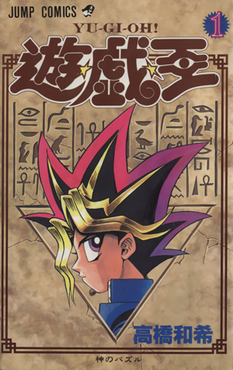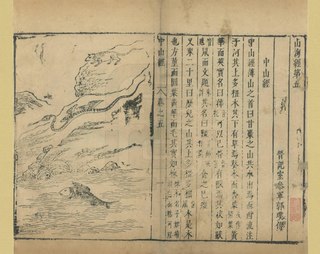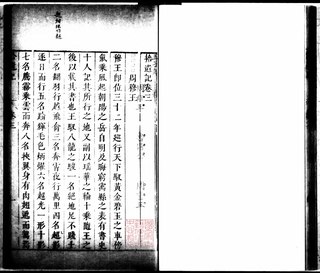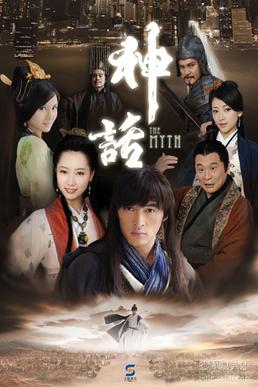
The Xia dynasty is the first dynasty in traditional Chinese historiography. According to tradition, it was established by the legendary figure Yu the Great, after Shun, the last of the Five Emperors, gave the throne to him. In traditional historiography, the Xia was succeeded by the Shang dynasty.

Mythology of the Haudenosaunee includes the creation stories and folktales of the Native Americans who formed the confederacy of the Five Nations Iroquois, later the Six Nations Iroquois Confederacy. Historically, these stories were recorded in wampum and recited, only being written down later. In the written versions, the spellings of names differ due to transliteration and spelling variations in European languages that were not yet standardized. Variants of the stories exist, reflecting different localities and times.
According to Chinese mythology and traditional Chinese historiography, the Three Sovereigns and Five Emperors were a series of sage rulers, and the first Emperors of China. Today, they are considered culture heroes, but they were widely worshipped as divine "ancestral spirits" in ancient times. According to received history, the period they existed in preceded the Xia dynasty, although they were thought to exist in later periods to an extent in incorporeal forms that aided the Chinese people, especially with the stories of Nüwa existing as a spirit in the Shang dynasty and Shennong being identified as the godly form of Hou Ji and a founder of the Zhou dynasty.

Chinese mythology is mythology that has been passed down in oral form or recorded in literature throughout the area now known as Greater China. Chinese mythology encompasses a diverse array of myths derived from regional and cultural traditions. Populated with engaging narratives featuring extraordinary individuals and beings endowed with magical powers, these stories often unfold in fantastical mythological realms or historical epochs. Similar to numerous other mythologies, Chinese mythology has historically been regarded, at least partially, as a factual record of the past.

YuYu Hakusho is a Japanese manga series written and illustrated by Yoshihiro Togashi. It tells the story of Yusuke Urameshi, a teenage delinquent who is struck and killed by a car while attempting to save a child's life. After a number of tests presented to him by Koenma, the son of the ruler of the afterlife, Yusuke is revived and appointed the title of "Underworld Detective". With this title he must investigate various cases involving demons and apparitions in the Human World, with the manga gradually becoming more focused on martial arts battles and tournaments as it progresses. Togashi began creating YuYu Hakusho around November 1990, basing the series on his interests in the occult and horror films and an influence of Buddhist mythology.

In the myths and folk religion of Chinese culture, the Jade Emperor or Yudi is one of the representations of the primordial god.

Yu-Gi-Oh! is a Japanese manga series written and illustrated by Kazuki Takahashi. It was serialized in Shueisha's Weekly Shōnen Jump magazine between September 1996 and March 2004. The plot follows the story of a boy named Yugi Mutou, who solves the ancient Millennium Puzzle. Yugi awakens a gambling alter-ego or spirit within his body that solves his conflicts using various games.

Yu the Great or Yu the Engineer was a legendary king in ancient China who was famed for "the first successful state efforts at flood control," his establishment of the Xia dynasty which inaugurated dynastic rule in China, and his upright moral character. He figures prominently in the Chinese legend titled "Great Yu Controls the Waters". Yu and other "sage-kings" of ancient China were lauded for their virtues and morals by Confucius and other Chinese teachers. He is one of the few Chinese monarchs who is posthumously honored with the epithet "the Great".

Yinglong is a winged dragon and rain deity in ancient Chinese mythology.

The Classic of Mountains and Seas, also known as Shanhai jing, formerly romanized as the Shan-hai Ching, is a Chinese classic text and a compilation of mythic geography and beasts. Early versions of the text may have existed since the 4th century BCE, but the present form was not reached until the early Han dynasty. It is largely a fabulous geographical and cultural account of pre-Qin China as well as a collection of Chinese mythology. The book is divided into eighteen sections; it describes over 550 mountains and 300 channels.

The Green Dragon Crescent Blade is a legendary weapon wielded by the Chinese general Guan Yu in the 14th-century historical novel Romance of the Three Kingdoms. It is a guandao, a type of traditional Chinese weapon.

Shi Yi Ji is a Chinese mythological / historical treatise compiled by the Taoist scholar Wang Jia. The title of the work has been variously translated into English as Record of Heretofore Lost Works, Researches into Lost Records, Record of Gleanings, or Forgotten Tales.

The Myth is a 2010 Chinese television series based on the 2005 Hong Kong film of the same title. Jackie Chan, who starred in the original film, was credited as the producer for the series, while Stanley Tong, who directed the film, was the creative director for the series. The series was first aired on CCTV-8 in China in January 2010.
Yu Rongguang, also known as Ringo Yu, is a Chinese actor and martial artist. He is best known for the title role in Iron Monkey along with Donnie Yen as well as being featured in films such as The East Is Red, My Father Is a Hero, and Musa.

China's Best Actor: Wen Jiabao is a book published by Chinese dissident author Yu Jie on August 16 in Hong Kong. The book is "a scathing critique" of China's premier Wen Jiabao, arguing that Wen's warm, empathic public persona was simply a facade, and that he shared the same goals of other Chinese leaders. It includes sections such as "How the myth of Wen Jiabao was created?" and "Skeptical view of online conversation between Wen Jiabao and netizens".
The Great Flood of Gun-Yu, also known as the Gun-Yu myth, was a major flood in ancient China that allegedly continued for at least two generations, which resulted in great population displacements among other disasters, such as storms and famine. People left their homes to live on the high hills and mountains, or nest on the trees. According to mythological and historical sources, it is traditionally dated to the third millennium BCE, or about 2300-2200 BCE, during the reign of Emperor Yao.
Xirang was a magical soil in Chinese mythology with the ability to self-expand and grow continuously. Its properties made it particularly effective for use by Gun and Yu the Great in fighting the rising waters of the Great Flood.

Fish are an important motif in Chinese mythology. There are various myths involving fish. Chinese mythology refers to those myths found in the historical geographic area of China. The geographic area of "China" is of course a concept which has evolved of changed through history. Fish in Chinese mythology include myths in Chinese and other languages, as transmitted by Han Chinese as well as other officially recognized 56 minority ethnic groups in China. The Chinese word for "fish", yu, is a homophone for "abundance", "plenty", and "affluence" ; therefore, fishes are a symbol of wealth. The Chinese dragon is the head of the fish clan. The act of fishing is also an important motif in Chinese mythology and culture.

The Yellow River Map, Scheme, or Diagram, also known by its Chinese name as the Hetu, is an ancient Chinese diagram that appears in myths concerning the invention of writing by Cangjie and other culture heroes. It is usually paired with the Luoshu Square—named in reference to the Yellow River's Luo tributary—and used with the Luoshu in various contexts involving Chinese geomancy, numerology, philosophy, and early natural science.
The Flood Mythology of China, or Great Flood of China is a deluge theme which happened in China. Derk Bodde (1961) stated that "from all mythological themes in ancient Chinese, the earliest and so far most pervasive is about flood." The mythology also has shared characteristics with other Great Floods all over the world, although it also has unique characteristics or different focuses. Lu Yilu (2002) groups all versions of great flood into three themes: "the heroes controls the flood; "brother-sister marriage to repopulating the world"; and "the flood which is drowning the whole city along with its citizens".














